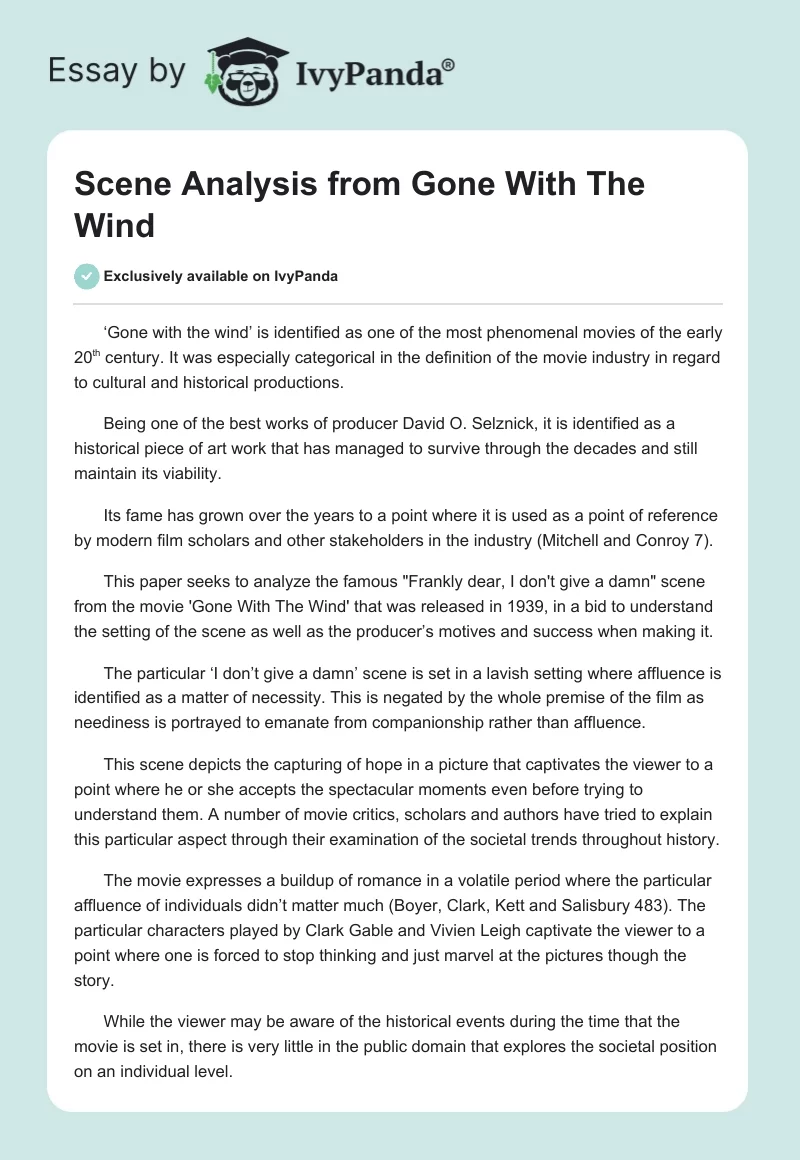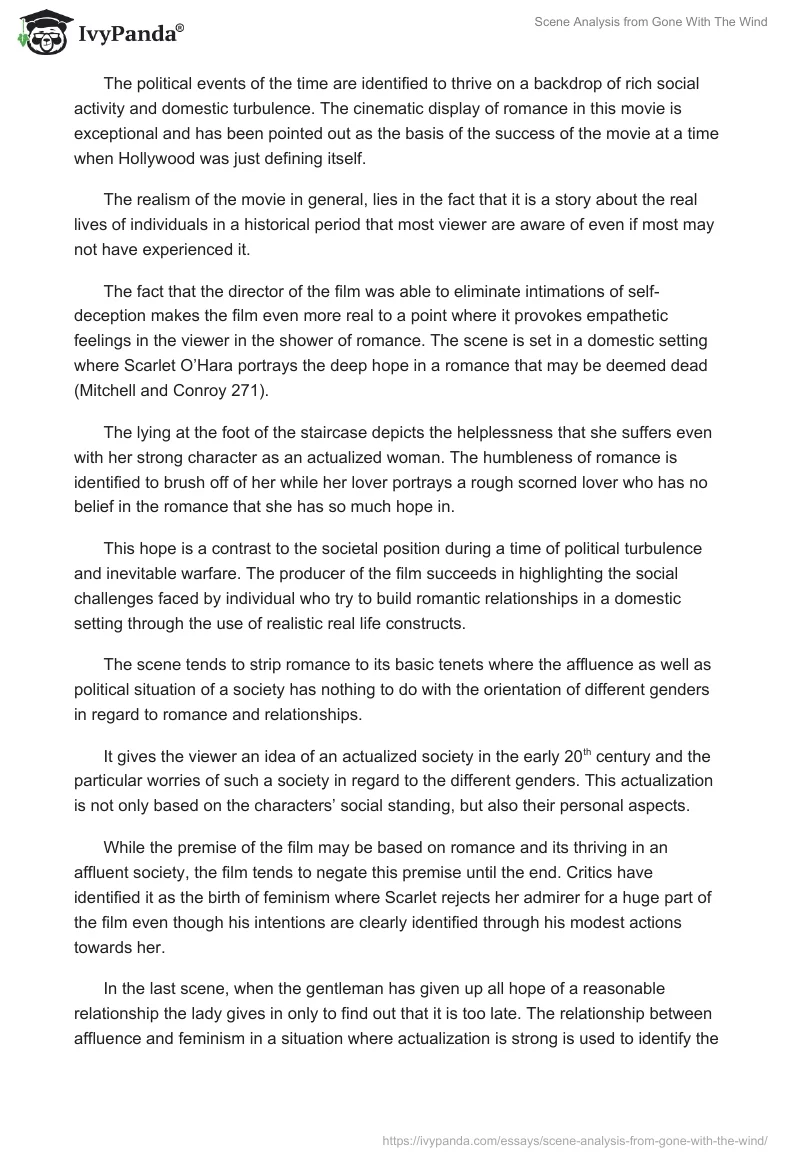‘Gone with the wind’ is identified as one of the most phenomenal movies of the early 20th century. It was especially categorical in the definition of the movie industry in regard to cultural and historical productions.
Being one of the best works of producer David O. Selznick, it is identified as a historical piece of art work that has managed to survive through the decades and still maintain its viability.
Its fame has grown over the years to a point where it is used as a point of reference by modern film scholars and other stakeholders in the industry (Mitchell and Conroy 7).
This paper seeks to analyze the famous “Frankly dear, I don’t give a damn” scene from the movie ‘Gone With The Wind’ that was released in 1939, in a bid to understand the setting of the scene as well as the producer’s motives and success when making it.
The particular ‘I don’t give a damn’ scene is set in a lavish setting where affluence is identified as a matter of necessity. This is negated by the whole premise of the film as neediness is portrayed to emanate from companionship rather than affluence.
This scene depicts the capturing of hope in a picture that captivates the viewer to a point where he or she accepts the spectacular moments even before trying to understand them. A number of movie critics, scholars and authors have tried to explain this particular aspect through their examination of the societal trends throughout history.
The movie expresses a buildup of romance in a volatile period where the particular affluence of individuals didn’t matter much (Boyer, Clark, Kett and Salisbury 483). The particular characters played by Clark Gable and Vivien Leigh captivate the viewer to a point where one is forced to stop thinking and just marvel at the pictures though the story.
While the viewer may be aware of the historical events during the time that the movie is set in, there is very little in the public domain that explores the societal position on an individual level.
The political events of the time are identified to thrive on a backdrop of rich social activity and domestic turbulence. The cinematic display of romance in this movie is exceptional and has been pointed out as the basis of the success of the movie at a time when Hollywood was just defining itself.
The realism of the movie in general, lies in the fact that it is a story about the real lives of individuals in a historical period that most viewer are aware of even if most may not have experienced it.
The fact that the director of the film was able to eliminate intimations of self-deception makes the film even more real to a point where it provokes empathetic feelings in the viewer in the shower of romance. The scene is set in a domestic setting where Scarlet O’Hara portrays the deep hope in a romance that may be deemed dead (Mitchell and Conroy 271).
The lying at the foot of the staircase depicts the helplessness that she suffers even with her strong character as an actualized woman. The humbleness of romance is identified to brush off of her while her lover portrays a rough scorned lover who has no belief in the romance that she has so much hope in.
This hope is a contrast to the societal position during a time of political turbulence and inevitable warfare. The producer of the film succeeds in highlighting the social challenges faced by individual who try to build romantic relationships in a domestic setting through the use of realistic real life constructs.
The scene tends to strip romance to its basic tenets where the affluence as well as political situation of a society has nothing to do with the orientation of different genders in regard to romance and relationships.
It gives the viewer an idea of an actualized society in the early 20th century and the particular worries of such a society in regard to the different genders. This actualization is not only based on the characters’ social standing, but also their personal aspects.
While the premise of the film may be based on romance and its thriving in an affluent society, the film tends to negate this premise until the end. Critics have identified it as the birth of feminism where Scarlet rejects her admirer for a huge part of the film even though his intentions are clearly identified through his modest actions towards her.
In the last scene, when the gentleman has given up all hope of a reasonable relationship the lady gives in only to find out that it is too late. The relationship between affluence and feminism in a situation where actualization is strong is used to identify the conflict between self-awareness and basic human tendencies that constitutes their humanity.
The producer builds up a lot of pressure through his use of suspense only to kill it through an unfortunate end where Scarlet gets rejected by her admirer (Boyer, Clark, Kett and Salisbury 76).
The use of music in the different scenes is quite articulate as it smoothly transfers the viewer’s feelings and moods from one setting to another, despite the conflict between the different scenes. This ensures that the story flows smoothly, which ensures the success of the production.
This also domesticates the scenes to a point where the viewer is able to connect and associate his or her personal life with that of the characters in the movie (Mitchell and Conroy 524). The producer manages to cascade the scenes in a progressive style while still providing room for soliloquies and flashbacks.
In the particular ‘I don’t give a damn’ scene, there is the inclusion of recollections from Scarlet’s father that reassure her of a positive future with her object of desire even though he had just rejected her.
This is identified as a point of weakness for the strong feminism that the film builds up in the previous scenes (Boyer, Clark, Kett and Salisbury 347). The poetic acts serve to emphasize the romance that exists in the domestic setting where external aspects of society seem to be blocked out to enhance the feelings of the characters.
The world that is constructed around the characters has been identified to emphasize the timelessness of the movie even though it is built around a historical setting.
This also emphasizes the timelessness of romance and this has been reiterated by modern film critics who identify it as the motivation behind the film’s success even in the modern world of film. Despite the fact that historical premise is boundless, the producer still manages to limit the storyline to a domestic context with a number of influences from the society.
Works Cited
Boyer, Paul, Clark Clifford, Kett Joseph and Salisbury Neal. The enduring vision: a history of the American people, Volume 2. Upper Saddle River: Cengage Learning. 2007. Print.
Mitchell, Margaret, and Conroy, Pat. Gone With the Wind. New York: Simon and Schuster. 2007. Print.


